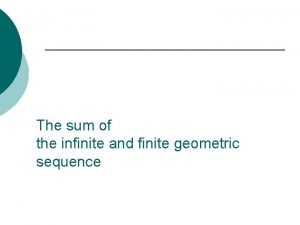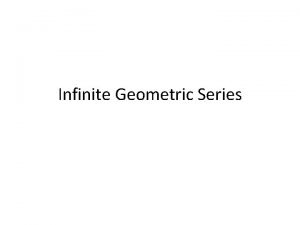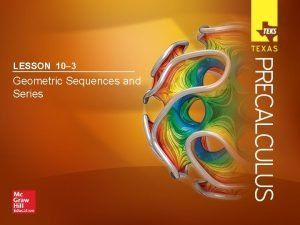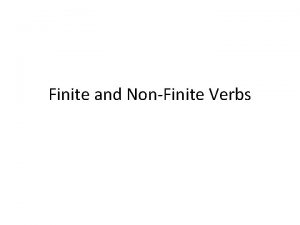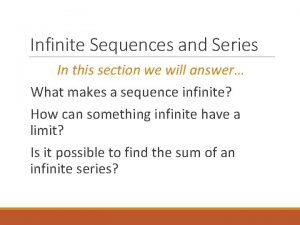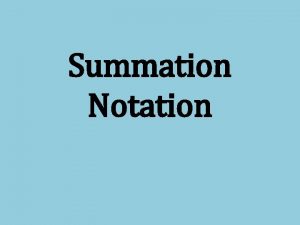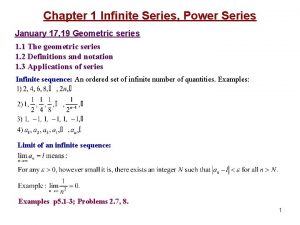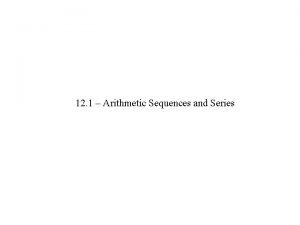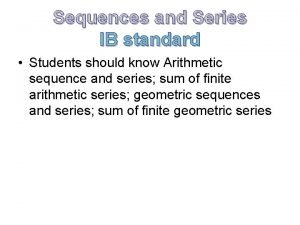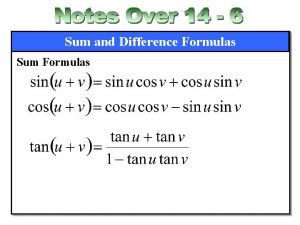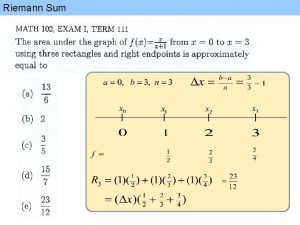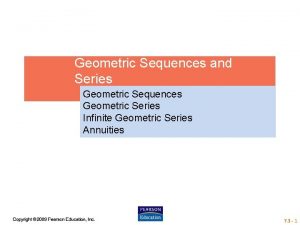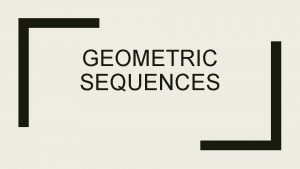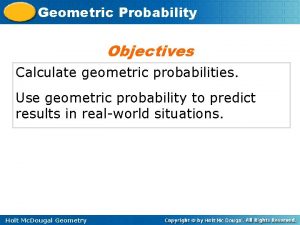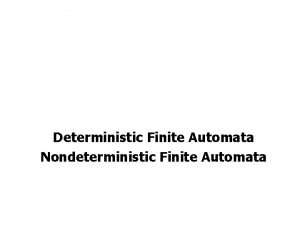The sum of the infinite and finite geometric




















- Slides: 20

The sum of the infinite and finite geometric sequence

The sum of the first n terms of a sequence is represented by summation notation. upper limit of summation index of summation lower limit of summation 2

The sum of a finite geometric sequence is given by 5 + 10 + 20 + 40 + 80 + 160 + 320 + 640 = ? n=8 a 1 = 5

The sum of the terms of an infinite geometric sequence is called a geometric series. If |r| < 1, then the infinite geometric series a 1 + a 1 r 2 + a 1 r 3 +. . . + a 1 rn-1 +. . . has the sum

Example: Find the sum of The sum of the series is

Convergent and Divergent Series

Convergent and Divergent Series If the infinite series has a sum, or limit, the series is convergent. ¡ If the series is not convergent, it is divergent. ¡

Ways To Determine Convergence/Divergence 1. Arithmetic – since no sum exists, it diverges ¡ 2. Geometric: ¡ If |r| > 1, diverges l If |r| < 1, converges since the sum exists 3. Ratio Test (discussed in a few minutes) l

Example Determine whether each arithmetic or geometric series is convergent or divergent. ¡ 1/8 + 3/20 + 9/50 + 27/125 +. . . l ¡ 18. 75+17. 50+16. 25+15. 00+. . . l ¡ r=6/5 |r|>1 divergent Arithmetic series divergent 65 + 13 + 2 3/5 + 13/25. . . l r=1/5 |r|<1 convergent

Other Series ¡ When a series is neither arithmetic or geometric, it is more difficult to determine whether the series is convergent or divergent.

Ratio Test In the ratio test, we will use a ratio of an and an+1 to determine the convergence or divergence of a series. Leading coefficient is a Review: Leading coefficient is d Denominator degree is greater

Test for convergence or divergence of: Since this ratio is less than 1, the series converges.

Test for convergence or divergence of: The ratio of the leading coefficients is 1 Since this ratio is less than 1, the series converges.

Test for convergence or divergence of: Coefficient of n 2 is 1 Since this ratio is 1, the test is inconclusive. Coefficient of n 2 is 1

Example ¡ Use the ratio test to determine if the series is convergent or divergent. 1/2 + 2/4 + 3/8 + 4/16 +. . . Since r<1, the series is convergent.

Example ¡ Use the ratio test to determine if the series is convergent or divergent. 1/2 + 2/3 + 3/4 + 4/5 +. . . Since r=1, the ratio test provides no information.

Example ¡ Use the ratio test to determine if the series is convergent or divergent. 2 + 3/2 + 4/3 + 5/4 +. . . Since r=1, the ratio test provides no information.

Example ¡ Use the ratio test to determine if the series is convergent or divergent. 3/4 + 4/16 + 5/64 + 6/256 +. . . Since r<1, the series is convergent.

Example ¡ Use the ratio test to determine if the series is convergent or divergent. Since r<1, the series is convergent.

Example ¡ Use the ratio test to determine if the series is convergent or divergent. Since r>1, the series is divergent.
 Finite geometric sum
Finite geometric sum Geometric series convergence
Geometric series convergence Geometric series formula
Geometric series formula Difference between finite and infinite series
Difference between finite and infinite series The main text of the book
The main text of the book Finite subordinate clause
Finite subordinate clause Finite verb
Finite verb Learning objectives of non finite verbs
Learning objectives of non finite verbs Finite and non-finite verb
Finite and non-finite verb Finite and non finite
Finite and non finite Infinite diversity in infinite combinations
Infinite diversity in infinite combinations What is finite loading
What is finite loading Formula for infinite geometric series
Formula for infinite geometric series Geometric sequence formulas
Geometric sequence formulas Summation notation
Summation notation Sum of gp
Sum of gp L'hopital's rule
L'hopital's rule Arithmetic series formula
Arithmetic series formula Arithmetic sequence meaning
Arithmetic sequence meaning Depreciation formula math
Depreciation formula math Geometric series sum
Geometric series sum
